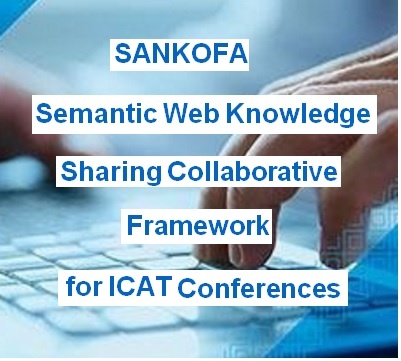AIMS, M2B and AGROVOC as a starting point for SANKOFA - a Semantic Web Knowledge Sharing Collaborative Framework
30/08/2017


Did you hear about SANKOFA? It is a Semantic Web Knowledge Sharing Collaborative Framework fostering the networking among the International Network on Appropriate Technology (INAT)* Community of Practice (CoP). INAT promotes Appropriate Technology (AT) to empower poorer people to achieve sustainable development.
SANKOFA enriches AT knowledge representation through transformation of International Conference on Appropriate Technology (ICAT)** publications to Resource Description Framework (RDF), Linked Data and Semantic Web technology.
|
# [PDF] SANKOFA: A Semantic Web Knowledge Sharing Collaborative Framework for ICAT Conferences The paper looks to INAT as CoP that produces AT Body of Knowledge (BOK) through all ICAT conferences. |
SANKOFA : FROM STARTING POINT ...
To create the SANKOFA Framework a Dublin Core approach similar to that of FAO’s Agriculture Information Management System (AIMS) was taken into consideration, as well as a series of metadata fields was identified to build core semantic representation (following the RDF Meaningful Bibliographic Metadata - M2B of the FAO of the UN) of the ICAT conference. In addition to M2B bibliographic metadata, the methodology of creation of SANKOFA includes also the text mining techniques aiming to help in semantic representation of all ICAT conferences.
The M2B based on Interlinked AT concepts ontology developed through Subject heading, Taxonomies, Topics, Associations, and Occurrences TAO, keywords, authors, and institution network analysis is going to:
- ensure the search of connected concepts;
- empover systematic collaboration of ontology revision;
- contribute to the growth AT Knowledge Base;
- enhace dynamics interaction of concepts with knowledge. Research blogging about peer reviewed papers and consultation within intra CoP enable further experts networking realize Science 2.0.
The SANKOFA Framework is guided by Simple Knowledge Organization System (SKOS) and implemented in current Durpal Content Management Platform that supports current ICAT conference website.
... TO STRATEGIC VISION
The SANKOFA Framework aims at:
- improving established interlinked documents with both interlinked open data and concept ontology, thus facilitating information retrieval;
- fostering network collaboration and
- enabling systematic growth of ontology related to AT BOK.
The methodology of creation of SANKOFA is disscused in the third section of the paper (#), while the fourth section presents results and future directions.
Last but not least...
* The community of International Network for Appropriate Technology (INAT) is the best example of Community of Practice (CoP ) and Network that create and disseminate the appropriate technology (AT) Body of Knowledge.
** International Conference on Appropriate Technology (ICAT) - the flagship of the INAT - promotes the AT movement.
